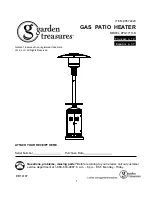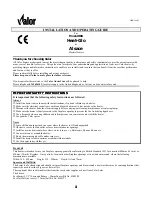
lp-672 Rev. 000 Rel. 002 Date 10.3.18
26
Figure 22 - Relief Valve Details
RE-INSPECTION OF RELIEF VALVES: Valves should be inspected
AT LEAST ONCE EVERY THREE YEARS, and replaced if necessary,
by a licensed plumbing contractor or qualified service technician
to ensure that the product has not been affected by corrosive
water conditions and to ensure that the valve and discharge line
have not been altered or tampered with illegally. Certain naturally
occuring conditions may corrode the valve and its components over
time, rendering the valve inoperative. Such conditions can only be
detected if the valve and its components are physically removed
and inspected.
Do not attempt to conduct an inspection on your
own.
Contact your plumbing contractor for a re-inspection to assure
continued safety.
Do not thread a cap or plug into the relief valve or relief valve line
under any circumstances! Explosion and property damage, serious
injury, or death may result.
FAILURE TO RE-INSPECT THE RELIEF VALVE AS DIRECTED COULD
RESULT IN UNSAFE TEMPERATURE AND/OR PRESSURE BUILD-UP
WHICH CAN RESULT IN PROPERTY DAMAGE, SERIOUS PERSONAL
INJURY, OR DEATH.
The water heater must be full of water and the system fully purged
BEFORE powering the water heater. When filling the water heater,
open a hot water tap to release air in the water heater and piping.
All air has been purged from the system when water runs freely from
the faucets.
Applying power to the water heater when it is not full of water will
damage the heat exchanger, and could result in property damage,
serious personal injury, or death. Such damages ARE NOT covered by
water heater warranty.
H. Filling the Heater
• Ensure any drain valves are completely closed.
• Open the shut-off valve in the cold water supply line.
• Open the hot water faucets to allow air to vent from the heater
and piping.
• Allow sufficient time for the heater to completely fill with water.
Part 5 - Venting
The heater must be vented as detailed in this section. Ensure
the exhaust vent and air intake comply with these instructions
regarding vent system. Inspect the installed appliance thoroughly
to ensure it complies with all applicable code requirements, as
well as the instructions provided in this manual. Failure to properly
install the appliance will result in severe personal injury or death.
A. General
This heater is certified as a “Category IV” appliance. This appliance
MUST BE INSTALLED OUTDOORS according to the rules outlined
in these instructions. Follow the venting instructions carefully.
Failure to do so will result in substantial property damage, severe
personal injury, or death.
1. Installation should be made in accordance with the regulations of
the Authority Having Jurisdiction, local code authorities, and utility
companies which pertain to this type of water heating equipment.
2. Install the venting system in accordance with these instructions
and with the National Fuel Gas Code, ANSI Z223.1/NFPA 54, CAN/
CGA B149, and / or applicable provisions of local building codes.
3. This water heater must be vented with materials, components,
and systems listed and approved for Category IV appliances.
The outdoor enclosure is not designed to carry heavy weight. Do
not stack anything on the water heater. Doing so could result in
substantial property damage, personal injury, or death.
















































